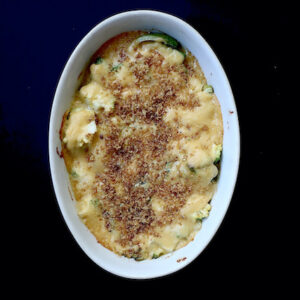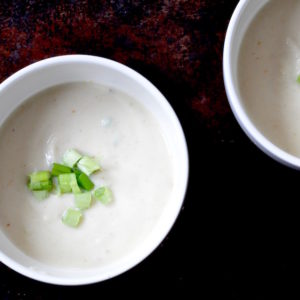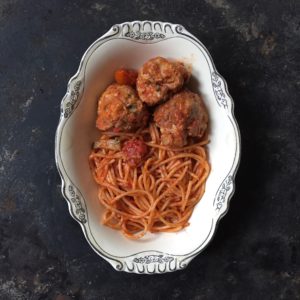Cauliflower with tomato and onion/Cauliflower Dum
As I mentioned in an earlier post, I’m working with The Greatest Tomatoes Of Europe Campaign, who sent me more tomatoes last week. They also invited me to meet them at the San Francisco Fancy Food Show, which was held at the Moscone Center January 19-22. I’ll share a few images from the show, but they (understandably) have strict rules about photography, and I have no interest in breaking them.

What to cook? A half-dozen dishes leapt to mind: beef stew, pasta (of course), stuffed cabbage, a winter tomato soup, topped with ample amounts of sour cream. Or I could scramble eggs with tomatoes. There’s always Tamasin Day-Lewis’s delicous pork belly with beans, which we cannot stop eating until it’s gone.

Each of those dishes is delicious. But I’d cooked them all countless times. Reader, I had fallen into a cooking rut. A comfortable, tasty rut. But a rut, regardless.

Determined to try something new, I landed on cauliflower dum, or cauliflower with tomatoes and onions. My recipe comes from two books: Jeffrey Alford and Naomi Duguid’s Mangoes and Curry Leaves, and Madhur Jaffrey’s An Invitation To Indian Cooking.

Cauliflower dum, or cauliflower with tomatoes and onions–whatever you wish to call it–is easy to make, even when you’re distracted and get flummoxed, as I did. Jaffrey takes a simple path, combining the aromatics in a blender, then tossing everything into a pot and letting it simmer itself to completion. Alford and Duguid take a more complex route, browning the cauliflower, setting it aside, popping cumin seeds, browning onions, adding the tomatoes, then, finally, assembling the dish, which they finish in a medium oven.

When cooking “wet” dishes like this one, I prefer having more control over the process, so I cooked the cauliflower stovetop. You can follow the Alford/Duguid method–not for nothing are they famous–and cook it in the oven, which should take a half hour or so. Atop the stove, expect it to take about 45 minutes before the cauliflower is tender. Either way, your house will smell wonderful.

Cauliflower Dum happens to be vegan and gluten-free, should you be searching for dinner-party dishes without faces, mothers, or gluten. Now that I think of it, cauliflower dum is kosher, too. So make a giant pot of rice, or flatbreads, or both, and invite your friends. Or eat it all yourself.

Being omnivorous, we ate our cauliflower dum with yogurt-marinated chicken, rice, and flatbreads. It was, to borrow a term from my UK friends, quite moreish. Hope for leftovers, which only improve with time, and are delicious cold.

Cauliflower Dum: Cauliflower with tomatoes and onions
With thanks to Mangoes and Curry Leaves, by Jeffrey Alford and Naomi Duguid and
An Invitation to Indian Cooking by Madhur Jaffrey
One small cauliflower serves 2 with rice as a main dish, or 2-3 as a side. To serve more people, buy two small heads of cauliflower or one large head
See notes for discussion of cooking methods.
Ingredients
one small to medium sized cauliflower
one small onion or shallot, peeled and finely chopped (see notes)
2-4 garlic cloves, peeled and crushed
approximately two teaspoons ginger, minced
1 teaspoon cumin seed
1 tablespoon coriander seed
1 half-teaspoon turmeric powder
1 teaspoon salt
1 teaspoon black pepper
2 cardamom pods, crushed
1 small bay leaf
1/2 fresh green chili pepper, seeded (see notes)
1 fifteen-ounce/445 ml can crushed tomatoes in juice
fresh lemon juice, to taste
additional salt, if needed
canola or peanut oil, for the pan
1 cup/235 ml water
This recipe takes much longer to describe than it does to cook. Please don’t be put off.
You will need a frying pan and lidded pot or saucepan that will hold your cauliflower and tomato sauce easily. Lacking a lid, foil will work.
A splatter screen is helpful here, as is a small food processor or mortar and pestle.
Cut the cauliflower into florets. Trim the leaves and stem for use in another recipe (stir fry, soup). Set aside.
Using either a mortar and pestle, blender, small food processor, or a really sharp knife, blend the onion, garlic, and ginger into a paste. Add the cumin, coriander, and turmeric. Blend. Add the salt, pepper, and cardamom. You should be able to pluck out the cardamom shells. You want a paste, but it need not be perfectly blended.
Returning to the cauliflower:
Have a lidded saucepan or pot that can hold your cauliflower and sauce ready. If you plan to cook the dish in the oven, preheat to 350F/180C.
Pour about 1/3 cup/75 ml oil into a large frying pan and heat to medium high. Add the cauliflower and brown, as if you were browning meat. Take care not to burn the veg or yourself; you may need to adjust the heat up or down. This is where the splatter screen is useful.
Keeping browning and turning, moving each piece of cauliflower to your pot.
Once all the cauliflower is browned, turn the heat under the frying pan down and add the onions. Stir occasionally, allowing onions to brown gently.
Add the spice paste to the onions. Pour in about 1/4 cup/60ml water and bring to a low boil. Add the hot pepper. Stir to blend.
Carefully transfer contents of frying pan to your cauliflower pot. Add the canned tomatoes. Stir to blend. Taste for seasoning–your may want to add more salt or a bit of lemon juice right away.
Cover and slide into oven, or bring to low simmer stovetop, covered, cooking until cauliflower is tender, 30-45 minutes.
Serve with rice, flatbreads, yogurt, or tandoori chicken.
Cauliflower dum keeps, refrigerated, up to five days (good luck). Do not freeze.
Notes:
Cauliflower dum may be prepared in the oven. Preheat to 350F/180C. Prepare ingredients to point of blending in saucepan. Cover with lid or foil and place in oven, cook about 30-40 minutes stirring occasionally, until cauliflower is soft.
Most cauliflower dum recipes call for up to one cup/454g onions. My husband is not fond of onion, so I substituted an inauthentic small shallot. If he weren’t eating this, I’d use the onion, and more of it.
Garam Masala is a spice mixture containing black peppercorns, cardamom, cinnamon, cloves, and coriander. (Mixtures vary, but that’s a standard blueprint.) As I always have these spices in the house, I never buy garam masala. Cauliflower dum recipes generally call for a teaspoon of garam masala. I added a bit of black pepper, two cracked cardamom pods, and additional coriander (the recipe calls for some already). I am not crazy about cinnamon and cloves in savory foods, so I ommitted them.
If you are preparing a larger cauliflower, add 3/4 cup/175 ml water to the cooking pot–or just fill the tomato can with water and pour it in.
Cauliflower dum is spicy. How spicy is up to you; Jaffrey’s recipe suggested either fresh hot pepper or cayenne; Alford and Duguid suggest 2 seeded green chilis. Given my husband’s preferences, I went on the mild side here.





